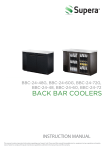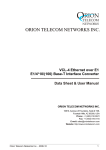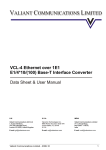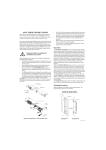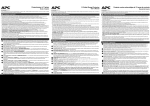Download Ativa 516-015 User's Manual
Transcript
2 CONNECT BATTERY CARTRIDGE 1 CONTENTS RJ-11 RJ-45 RJ-11 RJ-45 USB RJ-45 Coax Coax 1 2 516-015 User Guide 3 OPERATING ENVIRONMENT Æ ATIVA User Guide 53 CHECK BUILDING WIRING 4 CONNECT EQUIPMENT / POWER FAULT INDICATOR Fax 32 - 104oF (0 - 40oC) Printer or Scanner Computer If the rear panel Building Wiring Fault (red) indicator is lit, a potential shock hazard exists due to one of the following conditions: • Open or high resistance ground • Hot and Neutral polarities are reversed • Overloaded neutral circuit Improper building wiring should be corrected by a qualified electrician. Do not use the UPS until the condition that caused the fault is corrected. Note: Improper building wiring will not prevent the UPS from operating, but it will limit its protection capability. 6 CONNECT MODEM/PHONE/FAX and TVSS Ground RJ-45/ RJ-11 Phone Jack External Disk or CD / DVD Drive Monitor RJ-45/ RJ-11 RJ-45/ RJ-11 From stand alone data line surge suppressor or electronic device If needed, the UPS features a TVSS ground screw for connecting the ground lead of any additional stand alone surge suppression devices, such as an ProtectNet product; or any electronic device with an external ground connection. RJ-45/ RJ-11 Computer Modem Port 7 SWITCH ON THE UPS Note: Allow the UPS to charge for a full or 24 hours prior to use. Press the front panel Power ON/OFF switch and observe that the following events occur after pressing and releasing the switch: • The blue On Line indicator flashes. • The yellow On Battery indicator lights while a SelfTest is being performed. • When Self-Test has successfully completed, only the blue On Line indicator will be lit. • If the internal battery cartridge is not connected (see Step 2 above), the blue On Line indicator, and red Replace Battery indicators will light. The UPS will also emit a chirping sound. OR Phone or Fax ON LINE CABLE IN ON BATTERY OVERLOAD CABLE OUT To 120 VAC Wall Outlet STATUS INDICATORS, ALARMS and CIRCUIT BREAKER There are four status indicators (lights) on the front panel of the UPS (On Line, On Battery, Overload, and Replace Battery). On Line Four Beeps Every 30 Seconds - this alarm is sounded whenever the UPS is running On Battery. Consider saving work in progress. Continuous Beeping - this alarm is sounded whenever a low battery condition is reached. Battery run-time is very low. Promptly save any work in progress, and exit all open applications. Shut down the operating system, computer and the UPS. On Battery Overload Continuous Tone - this alarm is sounded whenever the Battery Backup outlets are overloaded. Replace Battery Chirps for 1 Minute Every 5 Hours - this alarm is sounded whenever the battery has failed the automatic diagnostic test. On Line (blue) - is lit whenever utility power is powering the Battery Backup outlets. On Battery (yellow) - is lit whenever the battery of the UPS is powering equipment connected to the Battery Backup Outlets. Overload (red) - is lit or flashing whenever power demand has exceeded the capacity of the UPS. Replace Battery (red) - is lit whenever the battery is near the end of its useful life, or if the battery is not connected (see above). A battery that is near the end of its useful life has insufficient run-time and should be replaced. Circuit Breaker - the circuit breaker button located on the rear panel of the UPS will stick out if an overload condition forces the UPS to disconnect itself from utility power. If the button sticks out, disconnect non-essential equipment. Reset the circuit breaker by pushing the button inward. Building Wiring Fault REPLACE BATTERY Building Wiring Fault Indicator TRANSFER VOLTAGE and SENSITIVITY ADJUSTMENT In situations where the UPS or connected equipment appears too sensitive to input voltage, it may be necessary to adjust the transfer voltage. This is a simple task requiring use of the front panel push button. To adjust the transfer voltage, proceed as follows: 1. Plug the UPS into the utility power source but do not turn the unit on. The UPS will be in Standby Mode (no indicators lit). 2. Press and hold the front panel ON/OFF switch fully inward for 10 seconds, until all LED indicators on the UPS flash to acknowledge it has entered Programming Mode. Release the ON/ OFF button, and the UPS's LEDs will flash per table below, indicating it's current sensitivity setting. Note: the UPS automatically exits programming mode in 5 seconds if no buttons are pressed. 3. Use the table below to decide which Sensitivity setting is desired. Indicators Flashing Sensitivity Setting Input Voltage Range (for utility operation) Use When 1 (yellow) Low 78 - 142 Vac Input voltage is extremely low or high. Not recommended for computer loads. 2 (yellow, and red) Medium (factory default) 88 - 139 Vac UPS frequently goes On Battery. 3 (yellow, red, and red) High 88 - 136 Vac Connected equipment is sensitive to voltage fluctuations. 4. To select the Low Sensitivity setting, press and hold the ON/OFF switch for 1-2 seconds (until a beep is heard). Upon release, the yellow indicator will flash, indicating Low Sensitivity. 5. To select the Medium Sensitivity setting (the unit's default), press and hold the ON/OFF switch for 1-2 seconds (until beep is heard). Upon release, the yellow indicator will flash. Press and hold the ON/OFF button again for 1-2 seconds (until beep is heard). Upon release, the yellow and one red indicator will flash, indicating Medium Sensitivity. 6. To select the High Sensitivity setting, press and hold the ON/OFF switch for 1-2 seconds (until beep is heard). Repeat this two more times. Upon final release, the yellow and two red indicators (bottom three indicators) will flash, indicating High Sensitivity. 7. The UPS will automatically exit Programming Mode in five seconds, and is ready for use. 990-2491 SPECIFICATIONS TROUBLESHOOTING Problem UPS will not switch on. Possible Cause Item Corrective Action UPS not connected to AC power source. Ensure the UPS is securely connected to an AC outlet. On-line Input Voltage Range (default settings) UPS circuit breaker “tripped”. Disconnect non-essential equipment from the UPS. Reset (push in) the rear panel circuit breaker. Switch on the UPS and plug in devices one at a time. If the circuit breaker trips again, disconnect the device that caused the breaker to trip. Automatic Voltage Regulation (AVR) Connect battery cartridge (see Connect Battery Cartridge). Maximum Load Consider adjusting the transfer voltage and sensitivity. See Transfer Voltage and Sensitivity Adjustment. Typical Recharge Time Internal battery is not connected. Utility input voltage quality is out of range. On-line Frequency Range On-battery Waveshape The UPS's plug has partially pulled out of the wall outlet, wall outlet has been turned off, or its circuit breaker has tripped. Verify the UPS's plug is fully inserted into the wall, and that power is present at the wall outlet. Unit is in the midst of performing an automatic self test. No action is necessary. Size (H x W x D) Utility input voltage is out of range, frequency is out of range or the wave form is distorted. Consider adjusting the transfer voltage and sensitivity. See Transfer Voltage and Sensitivity Adjustment. Weight UPS is heavily loaded. Unplug non-essential equipment (printers, scanners, etc.) from the Battery Backup outlets and plug into 'Surge Only' outlets. EMI Classification UPS battery cartridge is discharged due to recent power outage and has not had time to recharge. Charge the battery cartridge for 24 hours. UPS runtime is reduced until the battery cartridge is fully charged. Battery has reached the end of its life. Replace battery cartridge (see Order Replacement Battery Cartridge). Operating / Storage Relative Humidity Refer to Replace Battery Cartridge, and replace the battery cartridge. Connected equipment is drawing more power than the UPS can provide. Move one or more equipment power plugs from Battery Backup outlets to Surge Only outlets. Blue On Line indicator is on and all other front panel indicators are flashing. Internal UPS fault. Contact Ativa Technical Support (see Ativa Contact Information). Stepped Sine Wave 720 W 24 Hours 23o to 113oF -5o to 45oC UPS operates on battery although utility power exists. Battery has reached the end of its life. +12% (Boost Only) 57 - 63 Hz (Autosensing) Storage Temperature Unplug device from 'Surge Only' outlet and move to a 'Battery Backup' outlet. Red Overload indicator is on or flashing. 88 - 139 VAC 32o to 104oF 0o to 40oC Equipment was plugged into a Surge Only outlet. Red Replace Battery indicator is on. 1200 VA Operating Temperature UPS does not power essential equipment during an outage. UPS does not provide expected backup time. LIMITED TWO YEAR PRODUCT WARRANTY Shipping Weight Approvals 0 to 95% non-condensing 8.7 inch X 5.1 inch X 13.8 inch 220 mm X 130 mm X 350 mm 29.7 lbs (13.5 kg) 33.2 lbs (15.1 kg) ODP PROVIDES THIS LIMITED WARRANTY IN LIEU OF ALL OTHER WARRANTIES EITHER EXPRESS OR IMPLIED. EXPRESSLY EXCLUDED ARE ALL WARRANTIES OF FITNESS FOR A PARTICULAR PURPOSE OR MERCHANTABILITY. ODP’S SOLE OBLIGATION AND THE USER’S EXCLUSIVE REMEDY UNDER THIS WARRANTY SHALL BE LIMITED TO THE REPAIR OR REPLACEMENT AT ODP’S SOLE DESCRETION AND COST, OF PRODUCT OR COMPONENTS. IN NO EVENT SHALL ODP, ITS AFFILIATES, SUBSIDIARIES, SUPPLIERS OR PARENT COMPANIES BE RESPONSIBLE FOR CONSEQUENTIAL, SPECIAL, OR INCIDENTIAL DAMAGES ARISING OUT OF A CLAIM OF DEFECTIVE PRODUCT EVEN IF ODP HAS BEEN ADVISED OF THE POSSIBILITY OF SUCH DAMAGES. FCC / DOC Class B Certified TUV C-US certified per UL 1778, CSA 22.2 No. 107.1, and NOM-001 Notice: This device complies with part 68 and part 15 of the FCC rules. Operation is subject to the following two conditions: (1) This device may not cause harmful interference. (2) This device must accept any interference received, including interference that may cause undesired operation. Note: This equipment has been tested and found to comply with the limits for Class B digital devices, pursuant to part 15 of the FCC Rules. These limits are designed to provide reasonable protection against harmful interference in a residential installation. This equipment generates, uses and can radiate radio frequency energy and, if not installed and used in accordance with the instructions, may cause harmful interference to radio or television reception, which can be determined by turning the equipment off and on. The user is encouraged to try to correct the interference by one or more of the following measures: • Reorient or relocate the receiving antenna. • Increase the separation between the equipment and the receiver. • Connect the equipment into an outlet on a circuit different from that to which the receiver is connected. • Consult the dealer or an experienced radio/TV technician for help. REPLACE BATTERY CARTRIDGE The limited warranty covers the original purchase of a new product used for normal commercial, personal or household use. Office Depot, Inc. (ODP) warrants its products will be free from defects in materials and workmanship (normal wear and tear excepted) for two (2) years from the date of purchase, except as provided below. ODP, at its option, will replace with a comparable product, free of charge, any product which fails under normal use as a result of such defect. This warranty does not apply to damage caused by fire, accident, negligence, misuse, improper cleaning or other circumstances not directly attributable to manufacturing defects. SOME STATES OR PROVINCES DO NOT ALLOW THE EXCLUSION OF IMPLIED WARRANTIES OR LIMITATIONS ON HOW LONG AN IMPLIED WARRANTY LASTS OR THE EXCLUSION OR LIMITATION OF INCIDENTIAL OR CONSEQUENTIAL DAMAGES, SO THE ABOVE LIMITATIONS MAY NOT APPLY TO YOU. THIS WARRANTY GIVES YOU SPECIFIC LEGAL RIGHTS, AND YOU MAY ALSO HAVE OTHER RIGHTS WHICH MAY VARY BY STATE OR PROVINCE. THIS WARRANTY APPLIES ONLY TO THE U.S. AND CANADA. ATIVA CONTACT INFORMATION For Technical Support and Returns, please call: 1-877-777-HELP (1-877-777-4357) On the bottom of this equipment is a label that contains, among other information, the FCC registration number and ringer equivalence number (REN) for this equipment. If requested, this information must be provided to the telephone company. Modifications not approved by the party responsible for compliance could void user’s authority to operate the equipment. 1 2 990-2491





